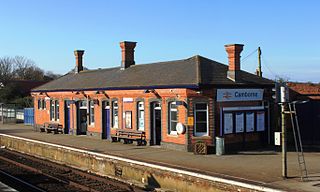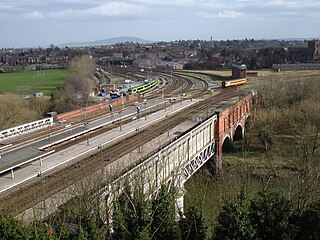
Lostwithiel signal box is a Grade II listed former Great Western Railway signal box, located on Lostwithiel railway station in Cornwall, England. The signal box is situated at the northern end of Platform 1, adjacent to the level crossing.

Lostwithiel signal box is a Grade II listed former Great Western Railway signal box, located on Lostwithiel railway station in Cornwall, England. The signal box is situated at the northern end of Platform 1, adjacent to the level crossing.
The single track of the Bodmin branch was controlled by an electric train staff until 28 December 1950, controlled by Bodmin Road Signal Box, after which an electric key token was used. Signalling on the branch was removed on 27 March 1968, after which points were operated by independent levers. Since Bodmin Road Signal Box was closed on 30 May 1985. [1] The lever frame controlling access to the Bodmin and Wenford Railway is operated under the supervision of Lostwithiel signal box.[ citation needed ]
In July 2013, it was one of 26 "highly distinctive" signal boxes listed by Ed Davey, Minister for the Department for Culture, Media and Sport, after a joint initiative by English Heritage and Network Rail to preserve and provide a window into how railways were operated in the past. [2] [3] [4] Historic England list the reasons for its designation as; intactness (it remains one of the best-preserved examples of what was once a standard signal box on the GWR network; date (it is considered to be the earliest known surviving GWR-designed type 5; and fittings (it retains original operating equipment including a lever frame and some train control instruments) [5] .

The Bodmin & Wenford Railway (BWR) is a heritage railway, based at Bodmin in Cornwall, England. It has an interchange with the national rail network at Bodmin Parkway railway station, the southern terminus of the line.

Plymouth railway station serves the city of Plymouth, Devon, England. It is on the northern edge of the city centre, close to the North Cross roundabout. It Is the second busiest station in the county of Devon, and is the largest of the six surviving stations in the city and the only one that is served by InterCity trains.

Bodmin Parkway railway station is on the Cornish Main Line that serves the nearby town of Bodmin and other parts of mid-Cornwall, England. It is situated 3 miles (4.8 km) south-east of the town of Bodmin in the civil parish of St Winnow, 274 miles 3 chains (441.0 km) from London Paddington measured via Box and Plymouth Millbay.

Lostwithiel railway station serves the town of Lostwithiel in Cornwall, England. It is 277 miles (446 km) from London Paddington via Bristol Temple Meads. Great Western Railway operates the station along with every other station in Cornwall.

Par railway station serves the villages of Par, Tywardreath and St Blazey, Cornwall, England. The station is 282 miles (454 km) from London Paddington via Bristol Temple Meads. It is the junction for the Atlantic Coast Line to Newquay.

St Austell station is a Grade II listed station which serves the town of St Austell, Cornwall, England. It is 286 miles (460 km) from London Paddington via Bristol Temple Meads. The station is operated by Great Western Railway, as is every other station in Cornwall.

Camborne railway station serves the town of Camborne, Cornwall, England. The station is 313 miles (504 km) from London Paddington via Bristol Temple Meads. It is located on Trevu Road in the town, adjacent to a level crossing and the Railway Hotel.

St Erth railway station is a Grade II listed station situated at Rose-an-Grouse in Cornwall, United Kingdom. It serves the nearby village of St Erth, which is about 0.75 miles (1.21 km) away, and is the junction for the St Ives Bay Line to St Ives. The station is 321 miles (517 km) measured from London Paddington via Bristol Temple Meads.

Plymouth Millbay railway station was the original railway terminus in Plymouth, Devon, England. It was used for passenger trains from 1849 to 1941. It was rebuilt in 1903.

Bishops Lydeard railway station is a heritage railway station in the village of Bishops Lydeard, Somerset, England. It is the southern terminus for regular trains on the West Somerset Railway.

Severn Bridge Junction is the area of railway lines just south of Shrewsbury railway station, in Shropshire, England. It is controlled by a mechanical interlocked signal box of the same name, which is now the largest operational mechanical signal box in the world. The Network Rail signalling area code is 'SBJ.'

The Cornwall Minerals Railway owned and operated a network of 45 miles (72 km) of standard gauge railway lines in central Cornwall, England, United Kingdom. It started by taking over an obsolescent horse-operated tramway in 1862, and it improved and extended it, connecting Newquay and Par Harbours, and Fowey. Having expended considerable capital, it was hurt by a collapse in mineral extraction due to a slump in prices. Despite its title, it operated a passenger service between Newquay and Fowey.
There are eight disused railway stations between Wadebridge and Bodmin North on the former Bodmin and Wadebridge Railway in Cornwall, in the United Kingdom, with ten other closed sidings on the branches to Ruthern Bridge and Wenfordbridge. The section from Boscarne Junction to Bodmin General is currently part of the Bodmin and Wenford Steam Railway; the line from Wadebridge to Wenfordbridge is now part of the Camel Trail, and the line to Ruthern Bridge can be followed for much of its length as it runs parallel to a public road.

Devonport Kings Road railway station was the London and South Western Railway station in Devonport, Devon, England. It opened in 1876 and closed in 1964. For the first 14 years it was a terminal station with trains to London departing eastwards, but from 1890 it became a through station with trains to London departing westwards.

Boscarne Junction railway station is a railway station on the Bodmin and Wenford Railway in Cornwall, United Kingdom, and is its current terminus of the railway. It is adjacent to the Camel Trail, a long-distance footpath and cycle trail.

Totnes Signal Box is a Grade II listed former Great Western Railway signal box, located on Totnes railway station. It presently functions as a cafe.

Par signal box is a Grade II listed former Great Western Railway signal box, located on Par railway station in Cornwall, England.

The Liverpool Street signal box is a Grade II listed disused signal box at Liverpool Street tube station in London.

Runcorn signal box is a railway control building sited at the south end of Runcorn railway station in Cheshire, England. It is located to the west of the West Coast Main Line and the branch line to Folly Lane. The signal box is recorded in the National Heritage List for England as a designated Grade II listed building. It was built by the London, Midland and Scottish Railway (LMS) in the early years of the Second World War incorporating the specifications of the Air Raid Precautions (ARP), and was one of the first of such signal boxes to be operational.